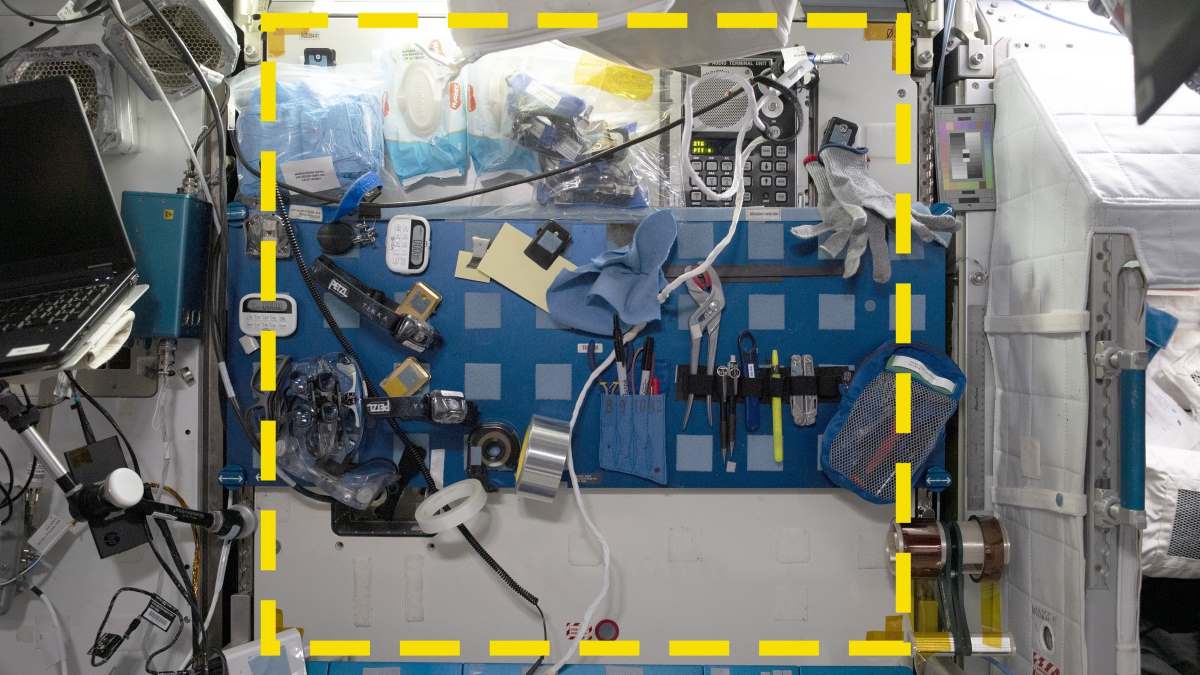The International Space Station (ISS) has been orbiting above our heads for nearly 26 years.
There are plans to decommission it in 2031, which has sparked a race for scientists understand the “microsociety” aboard the ISS before it is lost forever.
The International Space Station Archaeological Project (ISAAP) is the first archaeological study outside of Earth, and the initial results are published this week in the journal PLOS ONE.
They provide unique insights into how astronauts adapt areas on the ISS to their needs, highlighting that not enough thought has been given to the design of storage and personal hygiene areas.
“We want to see what archeology can tell us about living in space that you can’t find out any other way,” says Alice Gorman of Australia’s Flinders University, co-author of the study and ISSAAP co-lead alongside Justin Walsh of Chapman University in the US.
“Archaeology … can tell you not what people said they did or thought they were going to do, but what they actually did, because the objects tell a different story.”
An archaeological ‘dig’ on the ISS
To do archaeology in space, Gorman and colleagues adapted a very basic archaeological strategy used on Earth – the shovel test pit.
Archaeologists working within a large area cannot excavate every square centimetre of it. Instead, they divide it up into 1m-by-1m squares and excavate some of them, digging down in fixed-depth layers one at a time to control chronological death. They then extrapolate out to get an idea of the entire site.
But, Gorman points out, there’s no dirt on the International Space Station.
“You can’t actually excavate anything and it’s only, at the moment, 23 years old. It’s not, you know, 6000 years old,” she says.
“So, we chose 6 locations in the space station to put up a 1 by 1 square on the wall. And the idea would be, instead of digging down 5cm and finding all the artifacts, one of the crew members would take a photograph of it and that would be the context,” explains Gorman.
“Then we’d record all the artifacts as if we’d taken them out of a sieve. And then the next day they’d take another photograph. So, instead of going backwards in time, the excavation went forwards in time and each photograph represents an archaeological layer.”
Ensuring all sites were photographed approximately 24 hours apart over the 60 days was key to making sure data collection was consistent across all 6 squares.
It all sounds rather simple to carry out on solid ground but becomes much more difficult in orbit.
The experiment could only use equipment already present on the ISS. The sample squares also had to tick a lot of boxes by representing different nation’s modules and different activities.
Sections of the wall also had to be free of encumbrances for as close to a 1m by 1m square as possible. Compromises had to be made, of course, so some of the squares turned out rectangular.
The researchers also had to dissuade astronauts from doing a spot of spring cleaning in preparation for the experiment.
“Some of the astronauts were like, ‘oh, you know, we’ll clean it up for your photograph’,” Gorman recalls.
“[We’re] like, no, no, no, no! We don’t want it cleaned up – it’s that stuff we want to photograph. So don’t take anything away, even if you think it looks messy.”
NASA astronaut Kayla Barron installs the first square for the Sampling Quadrangle Assemblages Research Experiment (SQuARE) in the Japanese Experiment Module (also known as Kibo) on the International Space Station, January 14, 2022. She places Kapton tape to mark the square’s upper right corner. Credit: NASA
Even astronauts need more storage
One of the squares was located in the US Node 2 Module’s Maintenance Work Area, which was designed to act as an area for crew to repair and clean equipment. In practice, there was nobody working there much of the time and the crew used it mainly for storage.
“So, 44% of the artifacts are what we call restraints – they’re meant to hold an artifact in place,” says Gorman.
“We’d been thinking for a while about how crew use things like Velcro and resealable plastic bags and carabiners and cords. They use them to create a little momentary instance of gravity, that quality where, if you put something down or let it go, it stays there.
“Now on Earth, we don’t even question that an object will stay where you put it. It’s in the background. But in microgravity, you create the effect of that by using one of these objects.”
According to Gorman, there are 6,000 lost objects on the ISS so knowing where things are and having them stay there is incredibly important.
“Adapting that work maintenance area for a storage area shows that, for the crew, this kind of sort of temporary storage is critical to how they do their tasks,” she says.
“There are proper storage areas … a couple of the modules are just mostly storage. But this is storage in action … They’re essential to how activities get carried out, because this stuff has to be put somewhere, and it has to be found somewhere.”
The findings suggest that future space habitat designers might need to optimise future workstations for functions like quick storage, in addition to actual work.
The other square analysed in this study was on a wall, located near exercise equipment and a Waste and Hygiene Compartment (WHC), in the multipurpose Node 3 “Tranquillity” module.
The researchers expected to record items related to personal hygiene there. But did not expect a crew member to store their toiletry bag out in such a public space for almost 2 months.
“Clearly one crew member always went back to that spot when they needed toiletries,” says Gorman.
“The fact that we saw for 52 days out of 60 a toiletry bag stored in the open so that a person could perform quite personal activities in that public space, the takeaway message from that is not enough thought has been given to hygiene and privacy in space stations.”
Larger WHCs and dedicated storage facilities, such as lockers, may allow astronauts to maintain their personal hygiene more privately.
These take-aways seem like something any astronaut could tell you after living on the ISS, but space archaeology provides the data to back them up.
“We have evidence to make these statements and we’ll get more evidence because these are only the first 2 squares that we’ve analysed,” says Gorman.
“I think when we’ve done the full analysis we’re going to have so many other questions … But we’re also very conscious that the International Space Station has a limited life.
“So, while we might not exhaust all the questions raised by our data, other people will be able to use [it]. We’re making a record of a neglected part of the [ISS] for future generations.”














/https://tf-cmsv2-smithsonianmag-media.s3.amazonaws.com/filer_public/d1/82/d18228f6-d319-4525-bb18-78b829f0791f/mammalevolution_web.jpg)






Discussion about this post